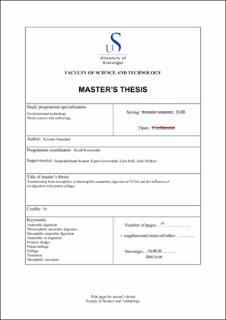| dc.contributor.advisor | Kumar, Gopalakrishnan | |
| dc.contributor.advisor | Govasmark, Espen | |
| dc.contributor.advisor | Solli, Linn | |
| dc.contributor.advisor | Morken, John | |
| dc.contributor.author | Haualand, Kristine | |
| dc.date.accessioned | 2021-01-28T09:21:22Z | |
| dc.date.available | 2021-01-28T09:21:22Z | |
| dc.date.issued | 2020-06 | |
| dc.identifier.uri | https://hdl.handle.net/11250/2725112 | |
| dc.description | Master's thesis in Environmental technology | en_US |
| dc.description.abstract | Anaerobic digestion (AD) is a microbial degradation process in the absence of oxygen by several complex biological reactions where polymeric organic carbon compounds are transformed into biogas and potential biofertilizer. The process is a well-established method for stabilizing solids and biosolids from the treatment of wastes. Traditionally, it has been applied for the treatment and stabilization of municipal sewage sludge (MSS) from wastewater treatment plants (WWTP), animal manure and slurries. As a result of increased environmental awareness, attention to waste management lead to the introduction of organic wastes from industry and municipal waste as biogas feedstock.
This study investigated the feasibility of transitioning from mesophilic anaerobic digestion (MAD) to thermophilic anaerobic digestion (TAD) at VEAS and also examined the effects of co-digestion with potato-stillage in lab-scale reactors. The transition was achieved successfully by a one-step increase in temperature where feeding was completely ceased for 15 days and target organic loading rate (OLR) was achieved after 33 days. Stable TAD was accomplished that matched the mesophilic digesters by biogas and methane yield and volatile solids (VS)-reduction. However, biogas production efficiency was reduced under thermophilic conditions in addition to poorer effluent quality containing large quantities of volatile fatty acids (VFAs). Co-digestion with potato-stillage improved the biogas and methane yield up to 5.7 and 3.3 % respectively. The improvement was most significant at mesophilic conditions. VS-destruction was increase up to 5.1 % and biogas production efficiency was improved under thermophilic conditions. According to the findings of this study, strategies to reduce the VFA-content of the thermophilic digestate should be considered if VEAS chooses to transition. Furthermore, co-digesting with potato-stillage benefitted the process and appears to be a lucrative option. | en_US |
| dc.language.iso | eng | en_US |
| dc.publisher | University of Stavanger, Norway | en_US |
| dc.relation.ispartofseries | Masteroppgave/UIS-TN-IKBM/2020; | |
| dc.subject | environmental technology | en_US |
| dc.subject | miljøteknologi | en_US |
| dc.title | Transitioning from mesophilic to thermophilic anaerobic digestion at VEAS and the influence of co-digesting primary sludge with potato-stillage | en_US |
| dc.type | Master thesis | en_US |
| dc.subject.nsi | VDP::Teknologi: 500::Miljøteknologi: 610 | en_US |
